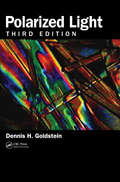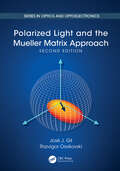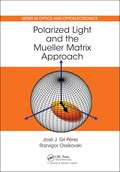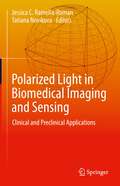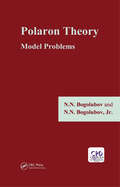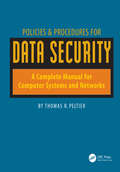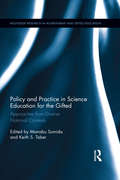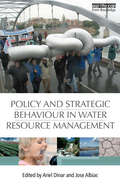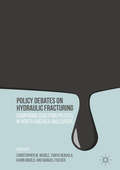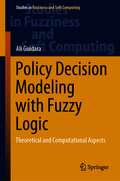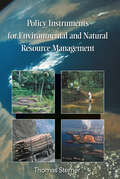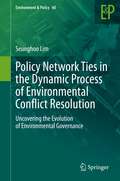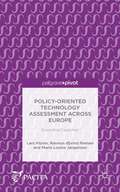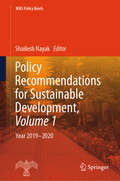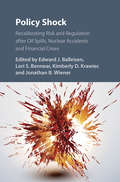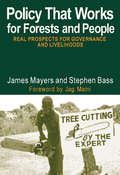- Table View
- List View
Polarized Light
by Dennis H. GoldsteinPolarized light is a pervasive influence in our world—and scientists and engineers in a variety of fields require the tools to understand, measure, and apply it to their advantage. Offering an in-depth examination of the subject and a description of its applications, Polarized Light, Third Edition serves as a comprehensive self-study tool complete with an extensive mathematical analysis of the Mueller matrix and coverage of Maxwell’s equations. Links Historical Developments to Current Applications and Future Innovations This book starts with a general description of light and continues with a complete exploration of polarized light, including how it is produced and its practical applications. The author incorporates basic topics, such as polarization by refraction and reflection, polarization elements, anisotropic materials, polarization formalisms (Mueller–Stokes and Jones) and associated mathematics, and polarimetry, or the science of polarization measurement. New to the Third Edition: A new introductory chapter Chapters on: polarized light in nature, and form birefringence A review of the history of polarized light, and a chapter on the interference laws of Fresnel and Arago—both completely re-written A new appendix on conventions used in polarized light New graphics, and black-and-white photos and color plates Divided into four parts, this book covers the fundamental concepts and theoretical framework of polarized light. Next, it thoroughly explores the science of polarimetry, followed by discussion of polarized light applications. The author concludes by discussing how our polarized light framework is applied to physics concepts, such as accelerating charges and quantum systems. Building on the solid foundation of the first two editions, this book reorganizes and updates existing material on fundamentals, theory, polarimetry, and applications. It adds new chapters, graphics, and color photos, as well as a new appendix on conventions used in polarized light. As a result, the author has re-established this book’s lofty status in the pantheon of literature on this important field.
Polarized Light and Optical Systems (Optical Sciences and Applications of Light)
by Russell A. Chipman Wai Sze Lam Garam YoungPolarized Light and Optical Systems presents polarization optics for undergraduate and graduate students in a way which makes classroom teaching relevant to current issues in optical engineering. This curriculum has been developed and refined for a decade and a half at the University of Arizona’s College of Optical Sciences. Polarized Light and Optical Systems provides a reference for the optical engineer and optical designer in issues related to building polarimeters, designing displays, and polarization critical optical systems. The central theme of Polarized Light and Optical Systems is a unifying treatment of polarization elements as optical elements and optical elements as polarization elements. Key Features Comprehensive presentation of Jones calculus and Mueller calculus with tables and derivations of the Jones and Mueller matrices for polarization elements and polarization effects Classroom-appropriate presentations of polarization of birefringent materials, thin films, stress birefringence, crystal polarizers, liquid crystals, and gratings Discussion of the many forms of polarimeters, their trade-offs, data reduction methods, and polarization artifacts Exposition of the polarization ray tracing calculus to integrate polarization with ray tracing Explanation of the sources of polarization aberrations in optical systems and the functional forms of these polarization aberrations Problem sets to build students’ problem-solving capabilities.
Polarized Light and the Mueller Matrix Approach (Series in Optics and Optoelectronics)
by José J. Gil Razvigor OssikovskiAn Up-to-Date Compendium on the Physics and Mathematics of Polarization Phenomena Now thoroughly revised, Polarized Light and the Mueller Matrix Approach cohesively integrates basic concepts of polarization phenomena from the dual viewpoints of the states of polarization of electromagnetic waves and the transformations of these states by the action of material media. Through selected examples, it also illustrates actual and potential applications in materials science, biology, and optics technology. The book begins with the basic concepts related to two- and three-dimensional polarization states. It next describes the nondepolarizing linear transformations of the states of polarization through the Jones and Mueller-Jones approaches. The authors then discuss the forms and properties of the Jones and Mueller matrices associated with different types of nondepolarizing media, address the foundations of the Mueller matrix, and delve more deeply into the analysis of the physical parameters associated with Mueller matrices. The authors proceed with introducing the arbitrary decomposition and other useful parallel decompositions, and compare the powerful serial decompositions of depolarizing Mueller matrices. They also analyze the general formalism and specific algebraic quantities and notions related to the concept of differential Mueller matrix. Useful approaches that provide a geometric point of view on the polarization effects exhibited by different types of media are also comprehensively described. The book concludes with a new chapter devoted to the main procedures for filtering measured Mueller matrices. Suitable for advanced graduates and more seasoned professionals, this book covers the main aspects of polarized radiation and polarization effects of material media. It expertly combines physical and mathematical concepts with important approaches for representing media through equivalent systems composed of simple components.
Polarized Light and the Mueller Matrix Approach (Series in Optics and Optoelectronics)
by Jose Jorge Perez Razvigor OssikovskiAn Up-to-Date Compendium on the Physics and Mathematics of Polarization Phenomena Polarized Light and the Mueller Matrix Approach thoroughly and cohesively integrates basic concepts of polarization phenomena from the dual viewpoints of the states of polarization of electromagnetic waves and the transformations of these states by the action of material media. Through selected examples, it also illustrates actual and potential applications in materials science, biology, and optics technology. The book begins with the basic concepts related to two- and three-dimensional polarization states. It next describes the nondepolarizing linear transformations of the states of polarization through the Jones and Mueller–Jones approaches. The authors then discuss the forms and properties of the Jones and Mueller matrices associated with different types of nondepolarizing media, address the foundations of the Mueller matrix, and delve more deeply into the analysis of the physical parameters associated with Mueller matrices. The authors proceed to interpret arbitrary decomposition and other interesting parallel decompositions as well as compare the powerful serial decompositions of depolarizing Mueller matrix M. They also analyze the general formalism and specific algebraic quantities and notions related to the concept of differential Mueller matrix. The book concludes with useful approaches that provide a geometric point of view on the polarization effects exhibited by different types of media. Suitable for novices and more seasoned professionals, this book covers the main aspects of polarized radiation and polarization effects of material media. It expertly combines physical and mathematical concepts with important approaches for representing media through equivalent systems composed of simple components.
Polarized Light in Biomedical Imaging and Sensing: Clinical and Preclinical Applications
by Jessica C. Ramella-Roman Tatiana NovikovaThis book focuses on biomedical applications of polarized light, covering instrumentation and modeling specific to the field. This will be the first book, written by leading researchers in the field, to tackle this important topic. Readers will learn the fundamentals of polarized light transport and how to develop instrumentation for clinical and preclinical studies. They will also become familiar with the latest advancement in data analysis and image processing for a variety of medical applications. The book is dedicated specifically to the biomedical community, including scientists, engineers, and physicians working on the development of instrumentation for clinical and preclinical use.Emphasizes biomedical imaging and sensing;Describes new computational approaches with examples;Provides detailed descriptions of novel instrumentation.
Polaron Theory: Model Problems
by N. N. Bogolubov Jr.Beginning with an introduction to the T-product approach in the theory of a particle interacting with bosonic fields as applied, for example, to the linearized polaron model, the book goes on to deal with the equilibrium state objective being to derive Bogolubov's inequality for the reduced free energy of the polaron. The third chapter deals with s
Polarons and Bipolarons: An Introduction (Chapman & Hall Pure and Applied Mathematics)
by Ashok Chatterjee Soma MukhopadhyayThis book provides a comprehensive review of the subject of polaron and a thorough account of the sophisticated theories of the polaron. It explains the concept of the polaron physics in as simple a manner as possible and presents the theoretical techniques and mathematical derivations in great detail. Anybody who follows this book will develop a solid command over the subject both conceptually and technically and will be in a position to contribute to this field.
Poled Polymers and Their Applications to SHG and EO Devices
by Seizo Miyata Hiroyuki SasabePoled polymers doped with nonlinear optically active chromophores combine the large second order nonlinearity of the dopant dye molecules with the optical quality of the polymer. The material design flexibility afforded to doped polymers makes them attractive in a large variety of devices and applications. This book addresses the critical science and technology issues in the development and application of poled polymers, with an emphasis on the stabilization of poled polymers and their special applications to second harmonic generation (SHG) and electro-optic (EO) devices.
Policies and Programs for Sustainable Energy Innovations
by Tugrul U. Daim Jisun Kim Ibrahim Iskin Rimal Abu Taha Kevin C. van BlommesteinThis volume features research and case studies across a variety of industries to showcase technological innovations and policy initiatives designed to promote renewable energy and sustainable economic development. The first section focuses on policies for the adoption of renewable energy technologies, the second section covers the evaluation of energy efficiency programs and the final section provides evaluations of energy technology innovations. Environmental concerns, energy availability and political pressure have prompted governments to look for alternative energy resources that can minimize the undesirable effects for current energy systems. For example, shifting away from the conventional fuel resources and increasing the percentage of electricity generated from renewable resources, such as solar and wind power, is an opportunity to guarantee lower CO2 emissions and to create better economic opportunities for citizens in the long run. Including discussions of such of timely topics and issues as global warming, bio-fuels and nuclear energy, the editors and contributors to this book provide a wealth of insights and recommendations for sustainable energy innovations.
Policies & Procedures for Data Security: A Complete Manual for Computer Systems and Networks
by Thomas PeltierHere‘s your how-to manual for developing policies and procedures that maintain the security of information systems and networks in the workplace. It provides numerous checklists and examples of existing programs that you can use as guidelines for creating your own documents.You‘ll learn how to identify your company‘s overall
Policing Patients: Treatment and Surveillance on the Frontlines of the Opioid Crisis
by Elizabeth ChiarelloA book that takes you inside the culture of surveillance that pits healthcare providers against their patientsDoctors and pharmacists make critical decisions every day about whether to dispense opioids that alleviate pain but fuel addiction. Faced with a drug crisis that has already claimed more than a million lives, legislatures, courts, and policymakers have enlisted the help of technology in the hopes of curtailing prescriptions and preventing deaths. This book reveals how this &“Trojan horse&” technology embeds the logics of surveillance in the practice of medicine, forcing care providers to police their patients while undermining public trust and doing untold damage to those at risk.Elizabeth Chiarello draws on hundreds of in-depth interviews with physicians, pharmacists, and enforcement agents across the United States to take readers to the frontlines of the opioid crisis, where medical providers must make difficult choices between treating and punishing the people in their care. States now employ prescription drug monitoring programs capable of tracking all controlled substances within a state and across state lines. Chiarello describes how the reliance on these databases blurs the line between medicine and criminal justice and pits pain sufferers against people with substance-use disorders in a zero-sum game.Shedding critical light on this brave new world of healthcare, Policing Patients urges medical providers to reaffirm their roles as healers and proposes invaluable policy solutions centered on treatment, prevention, and harm reduction.
Policing Wars
by Caroline HolmqvistHolmqvist presents an original account of the relationship between war and policing in the twenty first century. This interdisciplinary study of contemporary Western strategic thinking reveals how, why, and with what consequences, the wars in Afghanistan and Iraq became seen as policing wars.
A Policy Analysis of Reserve Retirement Reform
by Beth J. Asch James Hosek Michael G. MattockAs the defense burden borne by reserve forces has increased, more attention has been paid to differences between retirement systems for the reserve and active components. This report analyzes the systems, discusses the importance of structuring compensation to enable management flexibility, considers obstacles and how they might be overcome, and provides a quantitative assessment of the reserve retention and cost effects of possible proposals.
Policy and Practice in Science Education for the Gifted: Approaches from Diverse National Contexts (Routledge Research in Achievement and Gifted Education)
by Manabu Sumida Keith S TaberGifted education has come to be regarded as a key national programme in many coutnries, and gifted education in science disciplines is now being recognised to be of major importance for economic and technological development. Despite these initiatives and developments internationally, there are very few discussions on gifted education in science drawing upon practices and experiences in different national contexts. In support of an international dialogue between researchers and practitioners, often working within isolated traditions, this book offers information on key influential approaches to science education for gifted learners and surveys current policy and practice from a diverse range of educational contexts. The volume offers an informative introduction for those new to studying gifted science education, as well as supporting the development of the field by offering examples of critical thinking about key issues, and accounts of the influences at work within education systems and the practical complexities of providing science education for the gifted. The contributions draw upon a variety of research approaches to offer insights into the constraints and affordancxes of working within particular policy contexts, and the strengths and challenges inherent in different approaches to practice. Chapters include: Teaching science to the gifted in English state schools: locating a compromised 'gifted & talented' policy within its systemic context Models of education for science talented adolescents in the United States: Past, present, and likely future trends Navigating the shifting terrain between policy and practice for gifted learners in Tanzania Science education for female indigenous gifted students in the Mexican context Gifted Science Education in the Context of Japanese Standardization This book will appeal to scholars, practitioners and policy makers who are in the field of gifted science education.
Policy and Strategic Behaviour in Water Resource Management
by Ariel Dinar Jose AlbiacWater resource management throughout the world is a very complicated issue, involving various aspects and dimensions and a well-coordinated set of policies. A well-designed water policy is a multi-faceted concerted intervention, which could be specific to just one set of political and physical socio-economic conditions. A framework to analyse the interaction between policy design and implementation can assist in improving both of these in various physical, economic and political situations. This book focuses on the interaction between policy making and strategic behaviour of policy makers, water users and other stakeholders, and how policy analysis and other analytical tools from the field of game theory and negotiation can improve policy design. The book presents analysis by high-level policy makers and policy analysts from various countries, to share experience regarding specific policy issues that are relevant to almost any country in the world, but may have been addressed differently in each country.
Policy Debates on Hydraulic Fracturing
by Christopher M. Weible Tanya Heikkila Karin Ingold Manuel FischerThis edited volume compares seven countries in North America and Europe on the highly topical issue of oil and gas development that uses hydraulic fracturing or "fracking. " The comparative analysis is based on the Advocacy Coalition Framework (ACF) and guided by two questions: First, in each country, what are current coalitions and the related policy output? Second, based on the current situation, what are the chances for future policy change? This book is the first to use a social science approach to analyze hydraulic fracturing debates and the first application of the ACF that is deliberately comparative. The contributions in this book advance our understanding about the formation of coalitions and development of public policy in the context of different forms of government and economically recoverable natural resources.
Policy Decision Modeling with Fuzzy Logic: Theoretical and Computational Aspects (Studies in Fuzziness and Soft Computing #405)
by Ali GuidaraThis book introduces the concept of policy decision emergence and its dynamics at the sub systemic level of the decision process. This level constitutes the breeding ground of the emergence of policy decisions but remains unexplored due to the absence of adequate tools. It is a nonlinear complex system made of several entities that interact dynamically. The behavior of such a system cannot be understood with linear and deterministic methods.The book presents an innovative multidisciplinary approach that results in the development of a Policy Decision Emergence Simulation Model (PODESIM). This computational model is a multi-level fuzzy inference system that allows the identification of the decision emergence levers.This development represents a major advancement in the field of public policy decision studies. It paves the way for decision emergence modeling and simulation by bridging complex systems theory, multiple streams theory, and fuzzy logic theory.
Policy Diffusion Dynamics in America
by Graeme BousheyPolicy Diffusion Dynamics in America integrates research from agenda setting and epidemiology to model factors that shape the speed and scope of public policy diffusion. Drawing on a data set of more than 130 policy innovations, the research demonstrates that the "laboratories of democracy" metaphor for incremental policy evaluation and emulation is insufficient to capture the dynamic process of policy diffusion in America. A significant subset of innovations trigger outbreaks - the extremely rapid adoption of innovation across states. The book demonstrates how variation in the characteristics of policies, the political and institutional traits of states, and differences among interest group carriers interact to produce distinct patterns of policy diffusion.
Policy Instruments for Environmental and Natural Resource Management
by Thomas Professor SternerAs Thomas Sterner points out, the economic 'toolkit' for dealing with environmental problems has become formidable. It includes taxes, charges, permits, deposit-refund systems, labeling, and other information disclosure mechanisms. Though not all these devices are widely used, empirical application has started within some sectors, and we are beginning to see the first systematic efforts at an advanced policy design that takes due account of market-based incentives. Sterner?s book encourages more widespread and careful use of economic policy instruments. Intended primarily for application in developing and transitional countries, the book compares the accumulated experiences of the use of economic policy instruments in the U.S. and Europe, as well as in select rich and poor countries in Asia, Africa, and Latin America. Ambitious in scope, the book discusses the design of instruments that can be employed in a wide range of contexts, including transportation, industrial pollution, water pricing, waste, fisheries, forests, and agriculture. Policy Instruments for Environmental and Natural Resource Management is deeply rooted in economics but also informed by perspectives drawn from political, legal, ecological, and psychological research. Sterner notes that, in addition to meeting requirements for efficiency, the selection and design of policy instruments must satisfy criteria involving equity and political acceptability. He is careful to distinguish between the well-designed plans of policymakers and the resulting behavior of society. A copublication of Resources for the Future, the World Bank, and the Swedish International Development Cooperation Agency (Sida).
Policy Network Ties in the Dynamic Process of Environmental Conflict Resolution: Uncovering the Evolution of Environmental Governance (Environment & Policy #60)
by Seunghoo LimExtensive previous research has investigated environmental conflict management issues in networked settings and the design of policy networks, but the emergence and evolution of self-organizing policy networks are still not fully understood. Especially misunderstood is the problem of how the multiple motivations or incentives of competing policy actors in conflictual situations affect their structures of interaction, as this issue has not been studied systematically. This book aims to address the following research questions: how do policy stakeholders cope strategically with collective action or environmental conflict resolution? How do they utilize or maintain formal and informal policy networks to resolve problems effectively? What motivates them to engage or be involved in collaborative or conflictual networks? What influences their networking or their decisions on partner selection for conflict resolution? This book consists of four studies. The goal of the first study is to examine the form of a policy network by focusing on how policy networks emerge and evolve at the micro-level to solve collective action dilemmas endemic to decentralized and democratized policy decision-making processes, particularly in the environmental conflict resolution arena. The goal of the second study is to examine the main policy actors and structural characteristics of network governance evolution in the dynamic process of environmental conflict resolution. The goal of the third study is to highlight the role of policy tie formality in the evolution of multiplex ties in the environmental conflict resolution process. The goal of the fourth study is to demonstrate the relationships between patterns of interactions among policy actors and their modified and adjusted strategic behaviours within policy networks and across advocacy coalitions.
Policy-Oriented Technology Assessment Across Europe: Expanding Capacities
by Lars Klüver Rasmus Øjvind Nielsen Marie Louise JørgensenPolicy-Oriented Technology Assessment Across Europe.
Policy Recommendations for Sustainable Development, Volume 1: Year 2019_2020 (NIAS Policy Briefs)
by Shailesh NayakThe book contains policy-related publications based on research conducted by the National Institute of Advanced Studies. These publications address and support sustainable development goals, such as energy and the environment, education, inequality, human development, and peace research, among others. This volume fosters comprehensive research focused on these global targets and endeavors to address some of society's greatest grand challenges. The book will be extremely beneficial for researchers, academicians, practitioners, and policymakers working in the areas of the 17 Sustainable Development Goals (SDGs).
Policy Reform and Adjustments in the Agricultural Sectors of Developed Countries
by David Blandford Berkeley HillThis book explores the policy implications of growing pressures for economic adjustment in the agricultural sectors of developed countries. The primary focus is on Europe and North America, but adjustment policies in other developed countries are discussed. Some chapters are based on an international workshop at Imperial College, London in October 2003, and an international symposium in Philadelphia in the spring of 2004.
Policy Shock: Recalibrating Risk and Regulation after Oil Spills, Nuclear Accidents and Financial Crises
by Edward J. Kimberly D. Balleisen Bennear Lori S. Krawiec Wiener Jonathan B.Policy Shock examines how policy-makers in industrialized democracies respond to major crises. After the immediate challenges of disaster management, crises often reveal new evidence or frame new normative perspectives that drive reforms designed to prevent future events of a similar magnitude. Such responses vary widely - from cosmetically masking inaction, to creating stronger incentive systems, requiring greater transparency, reorganizing government institutions and tightening regulatory standards. This book situates post-crisis regulatory policy-making through a set of conceptual essays written by leading scholars from economics, psychology and political science, which probe the latest thinking about risk analysis, risk perceptions, focusing events and narrative politics. It then presents ten historically-rich case studies that engage with crisis events in three policy domains: offshore oil, nuclear power and finance. It considers how governments can prepare to learn from crisis events - by creating standing expert investigative agencies to identify crisis causes and frame policy recommendations.
Policy That Works for Forests and People: Real Prospects for Governance and Livelihoods
by Stephen Bass James MayersSince its original publication by the International Institute for Environment and Development in 1999, Policy That Works for Forests and People has been recognised as the most authoritative study to date of policy processes that affect forests and people. Providing a thorough analysis of the issues, options and factors that determine different outcomes and bolstered by a major annex containing tools and tactics, the book offers clear and practical advice on how to formulate, manage and implement policies appropriate to different contexts. These are policies that result in real improvements in the governance, use and economic benefits that can flow from forests to those who depend upon them. This book is essential reading for policy-makers, forestry practitioners and academics and students in all areas of forest policy, management and governance.
